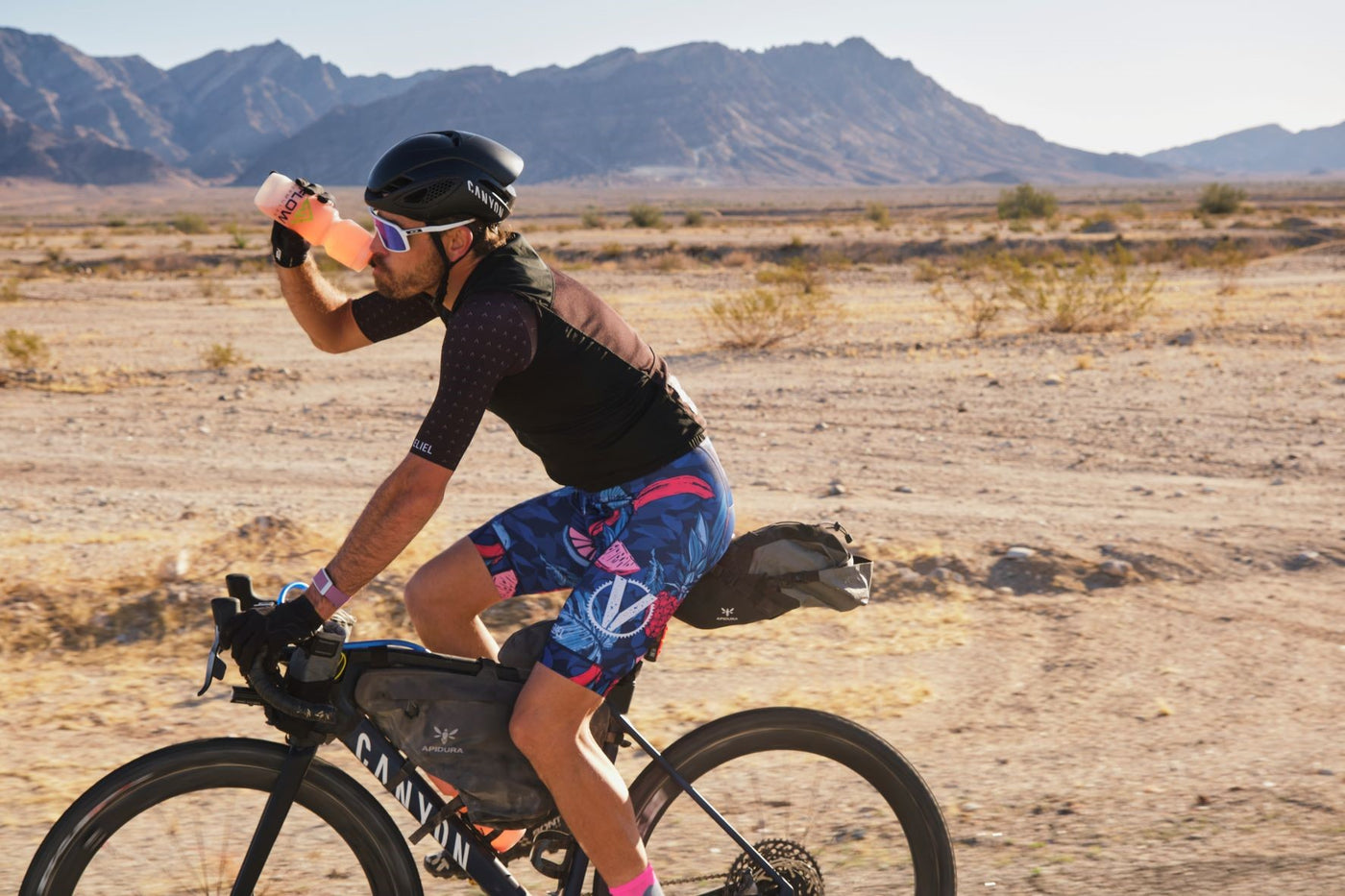Endurance Drink Research
Flow Formulas Endurance Drink Mix is the first research-based, allergen-free endurance sports drink for athletes who push their bodies to perform at optimal levels.
To make this product, we set out with three main goals:
- To make a product built from the current nutritional and sports-performance research for optimal performance
- For the product to be enjoyable as well as effective in replacing needed nutrients during hard racing and training efforts
- For this product to be free of the most common allergens (gluten, dairy, corn, peanuts, tree nuts, soy, egg, fish, shellfish, sesame, coconut and mustard)
Research shows using the optimal amount, the right types, and the right ratios of carbohydrates helps you to feel better, perform better and go farther. This table shows the current research for the optimal amount of carbohydrates, fluids, and electrolytes per hour. Even for events lasting one hour - research over the last few decades shows a 12% increase in performance with optimal carbohydrates and fluid intake. [1]
| Research | Competitors | Race 90 | |
|---|---|---|---|
| Optimal Performance | 78-102 grams carbs/hour | 43 grams | 90 grams |
| Maximum Absorption | 0.7-1.1 ratio fructose:glucose | <0.5:1 | 0.8:1 |
| Electrolyte Replacement | 460-690 mg sodium | 375 mg | 590 mg |
| Ideal Hydration | 13.5-27 ounces fluid | 14-21 oz. | 16-24 oz. |
| Research | Competitors | Race 90 |
|---|---|---|
| Optimal Performance | ||
| 78-102 grams carbs/hour | 43 grams | 90 grams |
| Maximum Absorption | ||
| 0.7-1.1 ratio fructose:glucose | ‹0.5:1 | 0.8:1 |
| Electrolyte Replacement | ||
| 460-690 mg sodium | 375 mg | 590 mg |
| Ideal Hydration | ||
| 13.5 - 27 ounces fluid | 14-21 oz. | 16-24 oz. |
[1] Below PR, Mora-Rodriquez R, Gonzalex-Alonso J, Coyle EF. Fluid and carbohydrate ingestion independently improve performance during 1 h of intense exercise. Medicine and Sciences in Sports and Exercise. 1995; 27:200-210.
Who would benefit from using the Endurance Drink Mix?
The Endurance Drink Mix is specifically designed as a sole source of fuel and fluid for endurance athletes performing continuous exercise greater than one hour.
Why doesn't the Endurance Drink Mix contain protein?
The research on endurance athletes ingesting protein supplements (branched amino acids) during exercise have mixed results and predominantly do not show improved results in performance. [1- 4]
[1] Tarpey, M. D., Roberts, J. D., Kass, L. S., Tarpey, R. J., & Roberts, M. G. (2013). The ingestion of protein with a maltodextrin and fructose beverage on substrate utilisation and exercise performance. Applied Physiology, Nutrition, and Metabolism, 38(12), 1245–1253.
[2] Oosthuyse, T., Carstens, M., & Millen, A. (2015). Whey or Casein Hydrolysate with Carbohydrate for Metabolism and Performance in Cycling. International Journal of Sports Medicine, 36(08), 636–646.
[3] Gui, Z., Sun, F., Si, G., Chen, Y. Effect of protein and carbohydrate solutions on performance and cognitive function in female recreational runners. Plos One. 2017 Oct 12;12(10):e0185982.
[4] Fink, H.H., Mikesky, A.E. (2015). Practical applications in sports nutrition. 4th ed. Burlington, MA: Jones & Barlett Learning.
Why do I need more calories per hour than I'm burning?
Below shows the estimated energy expenditure of a 135 pound individual performing different types of exercise. As you can see the 360 calories consumed through Flow Formulas is still considerably less than the energy expended through exercise. [1]
Female Athlete
Running 10 min/mile 550 kcal/hr
Running 6:30 min/mile 825 kcal/hr
Bicycling vigorous/racing 660 kcal/hr
Swimming freestyle vigorous 550 kcal/hr
[1] Dunford, M., & Doyle, JA. (2015). Nutrition for sport and exercise. 3rd. ed. Stamford, CT: Cengage Learning.
Should I always use 90 grams of carbohydrate when I exercise?
Typically you will not need to ingest carbohydrates in activities lasting under 90 minutes. In exercise bouts of over 90 minutes it is important to start training your gut. Initially, some athletes may not be able to tolerate more than 60-75 grams per hour. If this is the case it is best to start with 60 grams per hour (two scoops) and work your way up to the full 90 grams per hour (three scoops) over a period of a month.
Why does the Endurance Drink Mix have a 0.8:1 fructose:glucose ratio?
Research to date shows an increase in carbohydrate utilization, absorption, and power output with ratios greater than 0.7:1 with the lowest GI discomfort (stomach fullness, abdominal cramping, and nausea) at a ratio of 0.8:1. [1-3]
[1] O’Brien, W. J., & Rowlands, D. S. (2011). Fructose-maltodextrin ratio in a carbohydrate-electrolyte solution differentially affects exogenous carbohydrate oxidation rate, gut comfort, and performance. American Journal of Physiology-Gastrointestinal and Liver Physiology, 300(1), G181–G189.
[2] O'Brien, W.J., Stannard, S.R., Clarke, J.A., Rowlands, D.S. Fructose–Maltodextrin Ratio Governs Exogenous and Other CHO Oxidation and Performance. Medicine & Science in Sports & Exercise, 45(9), 1814–1824.
[3] Rowlands, D. S., Houltham, S., Musa-Veloso, K., Brown, F., Paulionis, L., & Bailey, D. (2015b). Fructose–Glucose Composite Carbohydrates and Endurance Performance: Critical Review and Future Perspectives. Sports Medicine, 45(11), 1561–1576.
Isn’t 90 grams over the recommended 30-60 grams of carbohydrate to the hour?
This recommendation is for single source carbohydrate solutions (glucose) as anything above 60 grams has showed delayed gastric emptying and increased abdominal distress. [1] In multisource carbohydrate solutions, absorption is significantly increased [2-5], one study even showed up to 55% more carbohydrate oxidation than single source carbohydrate solutions. [2]
[1]. Dunford, M., & Doyle, J. A. (2015). Nutrition for Sport and Exercise. 3rd. Ed. Stamford, CT: Cengage Learning.
[2] Roberts, J. D., Tarpey, M. D., Kass, L. S., Tarpey, R. J., & Roberts, M. G. (2014). Assessing a Commercially Available Sports Drink on Exogenous Carbohydrate Oxidation, Fluid Delivery and Sustained Exercise Performance. Journal of the International Society of Sports Nutrition, 11(1), 1–14.
[3] Jentjens, R. L. P. G., Moseley, L., Waring, R. H., Harding, L. K., & Jeukendrup, A. E. (2004). Oxidation of Combined Ingestion of Glucose and Fructose During Exercise. Journal of Applied Physiology, 96(4), 1277–1284.
[4] Jentjens, R. L. P. G., Underwood, K., Achten, J., Currell, K., Mann, C. H., & Jeukendrup, A. E. (2006). Exogenous Carbohydrate Oxidation Rates are Elevated After Combined Ingestion of Glucose and Fructose During Exercise in the Heat. Journal of Applied Physiology, 100(3), 807–816.
[5] Rowlands, D. S., Houltham, S., Musa-Veloso, K., Brown, F., Paulionis, L., & Bailey, D. (2015). Fructose–Glucose Composite Carbohydrates and Endurance Performance: Critical Review and Future Perspectives. Sports Medicine, 45(11), 1561–1576.
Isn’t the Endurance Drink Mix over the 6-8% carbohydrate solution recommendation?
The original purpose of the 6-8% solution guideline was to prevent slowing of gastric emptying which leads to GI distress. Multiple studies prove that solutions with multiple carbohydrate sources (i.e. glucose and fructose) increase gastric emptying and allow much higher than a 8% carbohydrate solution without additional GI distress. [1-6] What does all this mean? Consuming a multisource carbohydrate solution allows you to absorb more energy for better performance. [3]
[1] Shi, X., Summers, R.W., Schedl, H.P., Flanagan, S.W., Chang, R., Gisolfi, C.V. (1995) Effects of Carbohydrate Type and Concentration and Solution Osmolality on Water Absorption. Medicine & Science in Sports & Exercise. Dec;27(12):1607-15.
[2] Jeukendrup, A. E., & Moseley, L. (2010). Multiple Transportable Carbohydrates Enhance Gastric Emptying and Fluid Delivery. Scandinavian Journal of Medicine & Science in Sports, 20(1), 112–121.
[3] Roberts, J. D., Tarpey, M. D., Kass, L. S., Tarpey, R. J., & Roberts, M. G. (2014). Assessing a Commercially Available Sports Drink on Exogenous Carbohydrate Oxidation, Fluid Delivery and Sustained Exercise Performance. Journal of the International Society of Sports Nutrition, 11(1), 8.
[4] Jentjens, R. L. P. G., Moseley, L., Waring, R. H., Harding, L. K., & Jeukendrup, A. E. (2004). Oxidation of Combined Ingestion of Glucose and Fructose During Exercise. Journal of Applied Physiology, 96(4), 1277–1284.
[5] JJentjens, R. L. P. G., Underwood, K., Achten, J., Currell, K., Mann, C. H., & Jeukendrup, A. E. (2006). Exogenous carbohydrate oxidation rates are elevated after combined ingestion of glucose and fructose during exercise in the heat. Journal of Applied Physiology, 100(3), 807–816.
[6] Rowlands, D. S., Houltham, S., Musa-Veloso, K., Brown, F., Paulionis, L., & Bailey, D. (2015). Fructose–Glucose Composite Carbohydrates and Endurance Performance: Critical Review and Future Perspectives. Sports Medicine, 45(11), 1561–1576.
Why does the Endurance Drink Mix contain sodium chloride as the only source of electrolytes?
Many other hydration products contain other types electrolytes such as potassium and magnesium but according to research these do not show any further benefits to hydration or performance. [1]
[1] Vitale, K., & Getzin, A. (2019). Nutrition and Supplement Update for the Endurance Athlete: Review and Recommendations. Nutrients, 11(6), 1289.
What are the top 12 allergens?
The Endurance Drink Mix is free from the following top 12 allergens: peanuts, tree nuts, dairy, soy, gluten, egg, fish, shellfish, corn, sesame, coconut and mustard.
Isn't citric acid and maltodextrin made from corn?
Finding corn-free ingredients for the Endurance Drink Mix was one of the biggest challenges in bringing this drink to the market. Almost all of the current endurance sports drinks use corn as a precursor for maltodextrin and citric acid. To get past this hurdle, we chose to use tapioca maltodextrin. It breaks down exactly like corn maltodextrin but removes the allergy symptoms that come from corn. Citric acid is typically derived from corn but can be found from a variety of fruits and plants. Our citric acid is derived from the molasses of beets, sugar cane, or cassava.
Why does the Race 90 with caffeine contain 184 mg caffeine per serving? Doesn't that seem like too much?
Originally, most of the research on caffeine and endurance athletes was at higher doses, 6 mg/kg and higher which would equate to 368 mg caffeine or about 3 cups coffee. According to research, caffeine enhances endurance performance in amounts of 3 mg/kg with little to no increased benefits in higher dosages. [1,2] Flow Formulas contains 184 mg caffeine which equates to about 3 mg/kg for a 135 pound individual.
[1] Desbrow, B., Biddulph, C., Devlin, B., Grant, G. D., Anoopkumar-Dukie, S., & Leveritt, M. D. The effects of different doses of caffeine on endurance cycling time trial performance. Journal of Sports Sciences. 2012 Dec; 30(2), 115-120.
[2] Desbrow, B., Irwin, C., Ellis, A., Okeeffe, B., Grant, G., & Leveritt, M. Caffeine Withdrawal and High Intensity Endurance Cycling Performance. Medicine & Science in Sports & Exercise. 2011 Mar; 42, 106.
How do I train my gut to tolerate the full serving of Race 90?
Below is a chart on how to train your gut to tolerate 90 grams of carbohydrate per hour.
Is the Endurance Mix Kosher?
While Flow Formula's does not have a kosher certification all of our ingredients have a kosher certificate.


